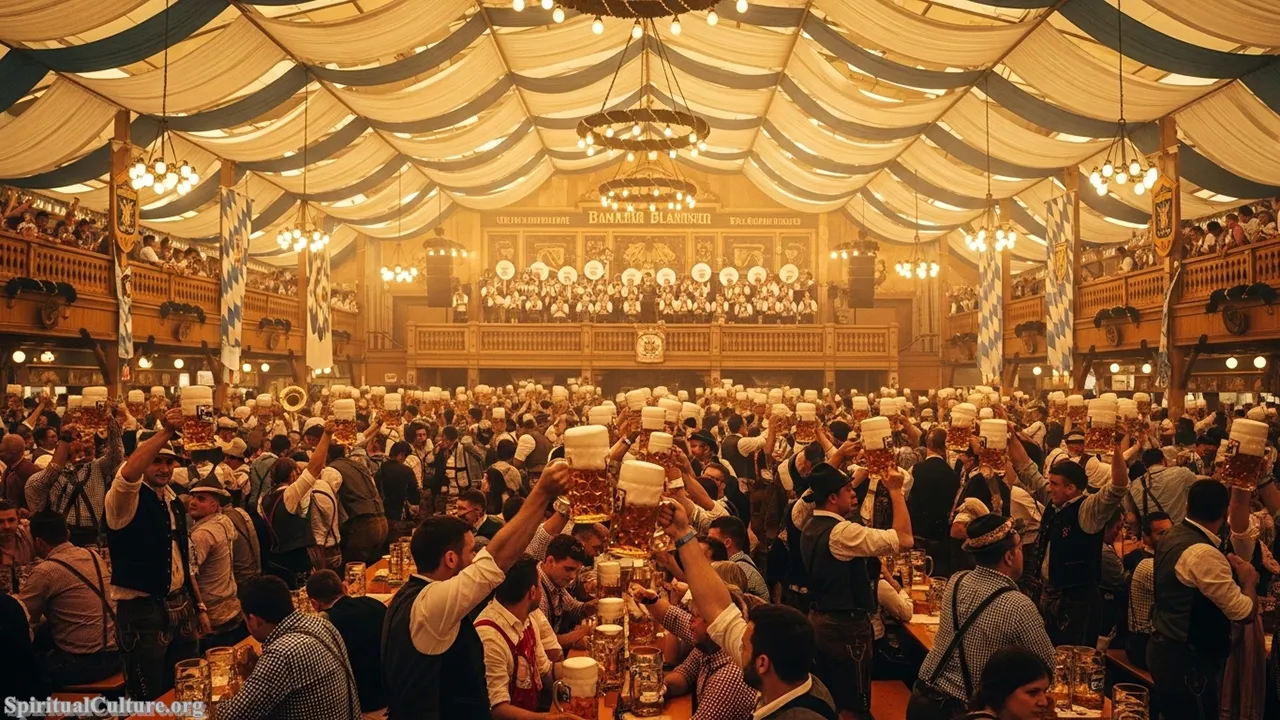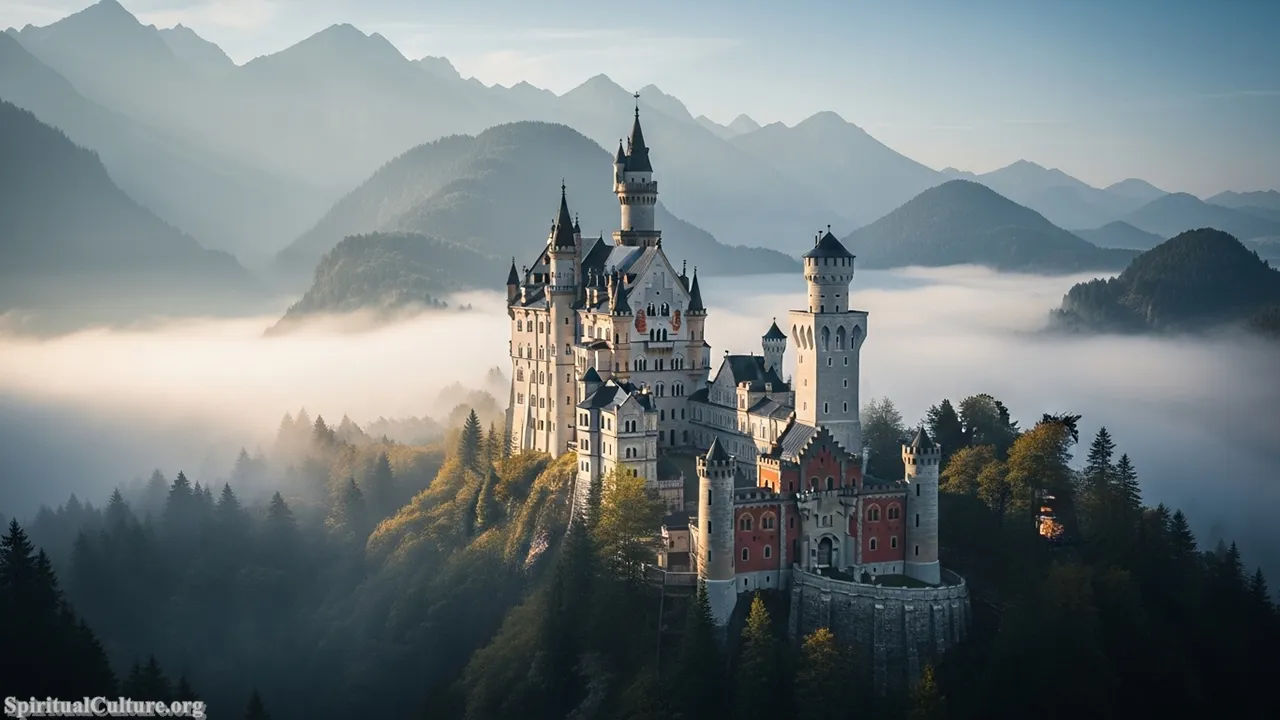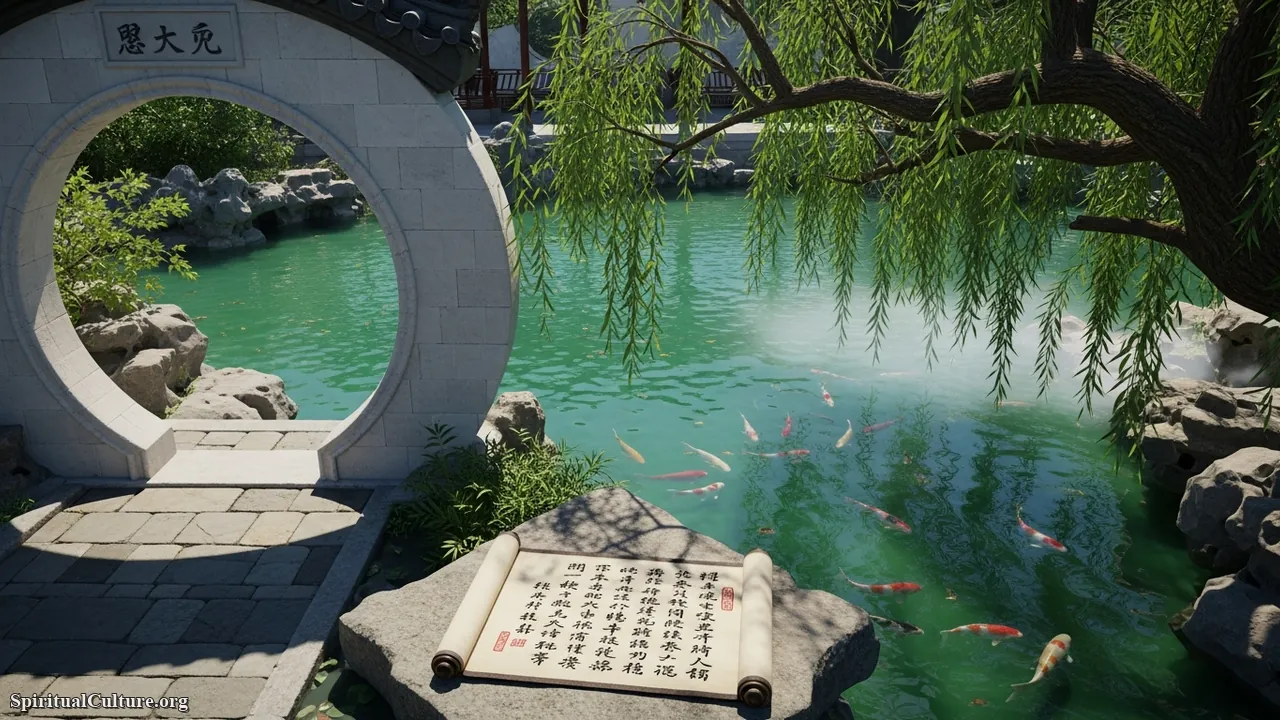The United Kingdom’s museum landscape is more than a collection of artifacts; it is a testament to the human spirit’s unyielding desire to understand its origin, its creativity, and its place in the cosmos. At Spiritual Culture, we believe that a museum is a modern temple of knowledge—a space where the boundaries between the past and the present dissolve, offering visitors a chance to reflect on the deeper narratives of civilization.
As of the Current Time of Writing (November 27, 2025), British museums continue to stand as global beacons of preservation and education. While visitor numbers often dictate popularity, our ranking incorporates a deeper metric: the “Spiritual Value” of the institution. We analyze how these spaces preserve the soul of a nation, foster cross-cultural dialogue, and house relics that have shaped human belief systems for millennia.
From the ancient corridors of the British Museum to the cosmic contemplations of Greenwich, this list curates the institutions that do not merely display history but invite you to experience the weight and wonder of it. The following data reflects the most current visitor trends and historical analysis available, establishing a reliable foundation for understanding the cultural magnitude of these sites.
Table of the Top 10 British Museums with the Greatest Spiritual Influence
| Rank | Museum Name | Location | Est. | Annual Visitors (Approx.) | Primary Spiritual/Cultural Significance |
|---|---|---|---|---|---|
| 1 | The British Museum | London | 1753 | ~6.5 Million | Global archive of human belief and religious history. |
| 2 | Natural History Museum | London | 1881 | ~6.3 Million | The Cathedral of Nature; stewardship of creation. |
| 3 | Tate Modern | London | 2000 | ~4.6 Million | Modern spirituality through abstract artistic expression. |
| 4 | The National Gallery | London | 1824 | ~3.1 Million | Western devotional art and Christian iconography. |
| 5 | Victoria and Albert Museum (V&A) | London | 1852 | ~3.1 Million | Material culture of faith and design heritage. |
| 6 | Science Museum | London | 1857 | ~3 Million | Philosophical ethics of life, death, and discovery. |
| 7 | National Museum of Scotland | Edinburgh | 2006 | ~2.3 Million | Celtic spirituality and national identity. |
| 8 | Royal Museums Greenwich | London | 1937 | ~2.5 Million | Cosmic connection, time, and navigation by stars. |
| 9 | Museum of Liverpool | Liverpool | 2011 | ~830,000 | Community spirit, resilience, and social justice. |
| 10 | Ashmolean Museum | Oxford | 1683 | ~500,000+ | Oldest public museum; archaeological views on death. |
Top 10. Ashmolean Museum (Oxford)
As the first public museum in Britain, the Ashmolean holds a unique spiritual weight as the “mother” of modern public knowledge sharing. Established in 1683, it transitioned the concept of a collection from a private “cabinet of curiosities” to a communal resource for enlightenment. Its location in Oxford places it at the intellectual heart of the nation, bridging the gap between academic rigor and public wonder.

Spiritually, the Ashmolean is profound because it houses artifacts that document humanity’s earliest attempts to grapple with mortality and the afterlife. The “Jericho Skull,” a plastered human skull from 9000 years ago, represents one of the oldest forms of ancestor worship and the human refusal to let death be the end. This artifact alone speaks volumes about the eternal human spirit and our innate need to preserve the essence of those we have lost.
The museum serves as a reminder that the act of collecting is, in itself, a spiritual act of remembrance. By preserving the tangible remains of lost civilizations, the Ashmolean acts as a guardian of collective memory, ensuring that the beliefs, rituals, and artistic expressions of our ancestors remain part of the living human conversation.
Cultural & Spiritual Highlights:
- The Jericho Skull: Evidence of early Neolithic ancestor veneration and spiritual connection to the dead.
- Protective Spirits: Houses ancient Assyrian reliefs of winged genii designed to ward off evil.
- Oldest Public Legacy: Created a paradigm shift in 1683: knowledge as a public right rather than a private privilege.
Top 9. Museum of Liverpool
The Museum of Liverpool is a powerful testament to the “Spirit of Place” (Genius Loci). Unlike museums that look outward to the world, this institution looks inward at the soul of a specific community, exploring the resilience, humor, and grit of the Liverpudlian identity. It stands on the historic waterfront, a UNESCO-recognized site that has witnessed centuries of migration, trade, and cultural exchange.

The spiritual impact here is found in the celebration of the “common man” and social justice. Exhibitions like “Yours Faithfully” have explored the diverse spiritual journeys of the city’s residents, while displays on the Blitz highlight the indomitable spirit of survival. It elevates the everyday struggles and triumphs of the working class to the level of heritage, suggesting that the spirit of a city is defined not by its rulers, but by its people.
We preserve culture here by honoring the collective voice. The museum acts as a mirror for the community, validating their experiences and struggles. It teaches us that “heritage” is not just ancient stones, but the living, breathing character of a society—its music, its protests, and its football chants—all of which are forms of secular devotion.
Cultural & Spiritual Highlights:
- “Spirit of the Blitz”: A moving tribute to resilience and communal survival during wartime.
- Diverse Faiths: Documented history of the city’s religious diversity through the “Yours Faithfully” initiative.
- Social Justice Focus: Highlights the spiritual importance of equality, protest, and community solidarity.
Top 8. Royal Museums Greenwich
Comprising the National Maritime Museum and the Royal Observatory, this site represents humanity’s spiritual connection to the cosmos. For centuries, Greenwich has been the center of time and navigation, the place where humanity organized the chaos of the globe into the order of longitude and time zones. It is where the heavens met the earth to guide sailors across the unknown abyss of the oceans.
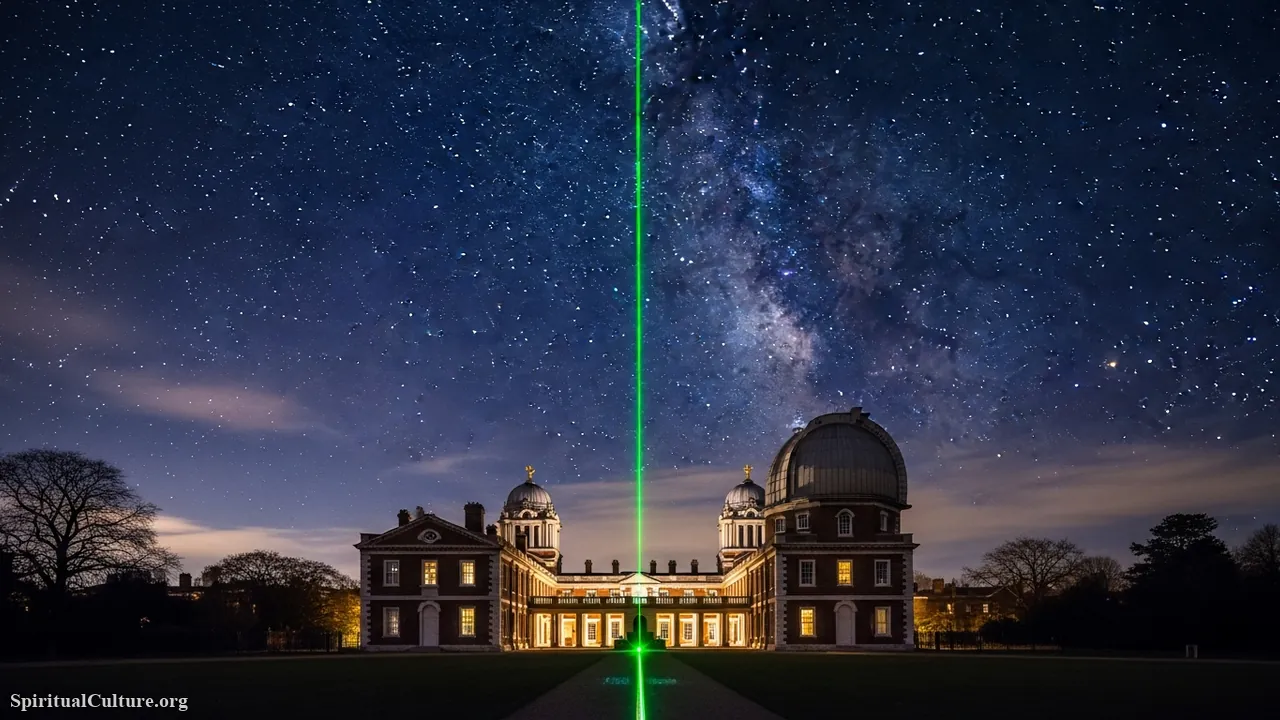
The spiritual significance lies in our relationship with the stars. The Prime Meridian line is not just a geographical marker but a symbol of humanity’s attempt to find its place in the universe. The museum explores the terrifying and majestic vastness of the sea and sky, prompting existential reflection on our smallness in the grand design of creation. The act of navigation is portrayed here as a faith-based trust in the order of the celestial spheres.
Preserving this heritage reminds us of the age of exploration, where science and faith were often intertwined. It teaches us that looking up at the stars has always been our method for finding our way home, a metaphor that resonates deeply with the spiritual seeker’s journey.
Cultural & Spiritual Highlights:
- Prime Meridian Line: The symbolic center of world time and a philosophical anchor for global unity.
- Harrison’s Timekeepers: Represents the human triumph of intellect over the chaotic forces of nature.
- Cosmic Perspective: The Observatory links human history directly to the movements of the universe.
Top 7. National Museum of Scotland (Edinburgh)
This institution is the custodian of the Scottish soul, housing the nation’s most sacred historical treasures. From the geological formation of the land to the modern era, the museum weaves a narrative of identity that is deeply rooted in the rugged landscape and the Celtic spirit. It is a place where the mystical past of Scotland is kept alive.
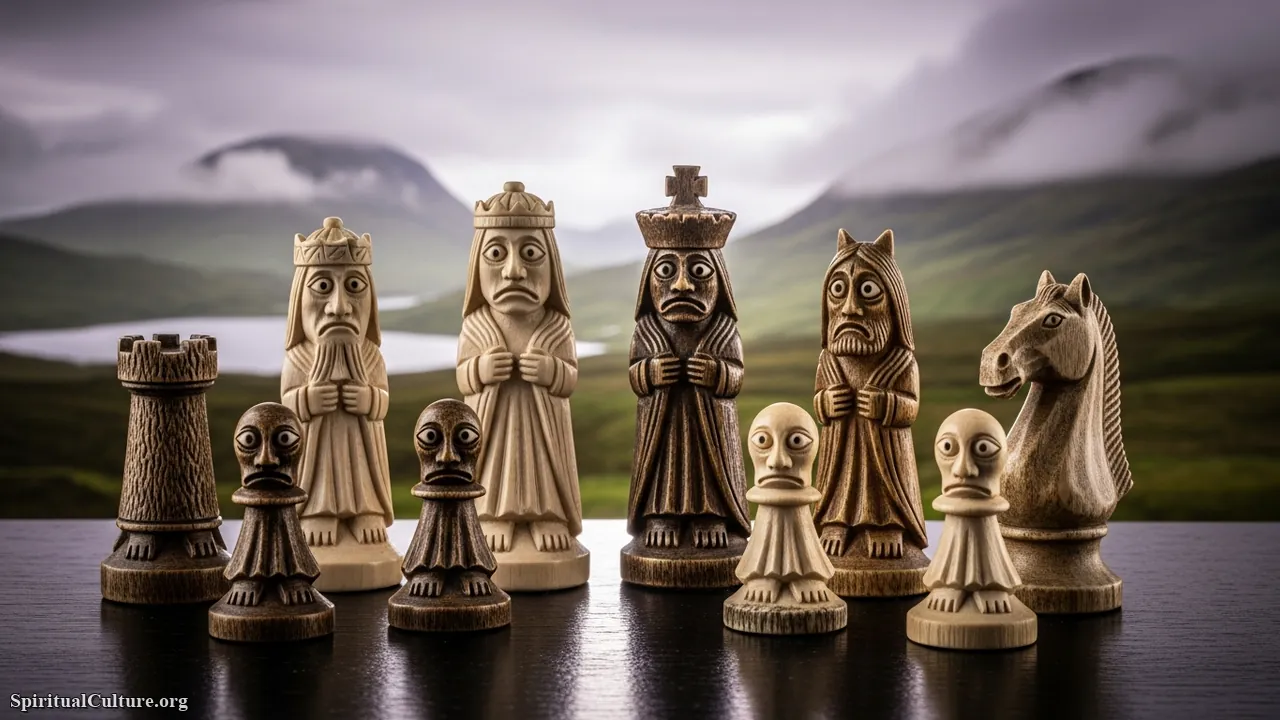
Central to its spiritual allure are the Lewis Chessmen. These 12th-century ivory figures are not mere game pieces; they are icons of medieval destiny, hierarchy, and the fatalism often found in Norse and Celtic lore. Their wide-eyed expressions seem to stare into eternity, evoking a sense of mystery about the hands that carved them and the minds that played with them. They represent the “game of life” played by our ancestors, subject to forces beyond their control.
The museum also preserves the Monymusk Reliquary, a sacred object believed to have carried the bones of St. Columba into battle. Such artifacts bridge the gap between national history and religious devotion, showing how faith was once the bedrock of national survival and identity.
Cultural & Spiritual Highlights:
- The Lewis Chessmen: Mysterious ivory figures representing fate, strategy, and Norse-Gaelic heritage.
- Monymusk Reliquary: A sacred vessel of St. Columba, highlighting the fusion of faith and warfare.
- Celtic Spirituality: Extensive collections of Pictish stones and early Christian crosses.
Top 6. Science Museum (London)
While seemingly secular, the Science Museum addresses the profoundest questions of existence: Where do we come from? What are we made of? And where are we going? It is a temple to the “Human Spirit of Inquiry.” The museum challenges visitors to consider the ethical and philosophical implications of our power to manipulate the building blocks of life and the fabric of reality.

The “Medicine: The Wellcome Galleries” are particularly spiritually potent, dealing directly with the fragility of the human body, the rituals of death, and the hope for healing. Past exhibitions like “Faith, Hope and Fear” have explicitly explored the intersection of science and spirituality, acknowledging that for many, the pursuit of scientific truth is a form of devotion to understanding the Creator’s work.
This institution teaches us that science is not the opposite of spirituality but a different language for describing the miracle of existence. From the vastness of space explored in the Apollo exhibits to the complexity of the genome, the museum evokes a sense of awe that is fundamentally spiritual.
Cultural & Spiritual Highlights:
- Medicine Galleries: A profound look at life, death, pain, and the human drive to heal.
- Clockmakers’ Museum: A philosophical meditation on Time, mortality, and mechanical perfection.
- Ethics of Creation: Exhibits on genetics and AI that question the definition of the soul.
Top 5. Victoria and Albert Museum (V&A)
The V&A is the world’s leading museum of art, design, and performance, but at Spiritual Culture, we view it as a treasury of “devotion made visible.” Design and craftsmanship are often acts of worship, and the V&A houses some of the most exquisite religious artifacts in the world, from Buddhist statues to medieval Christian altarpieces.
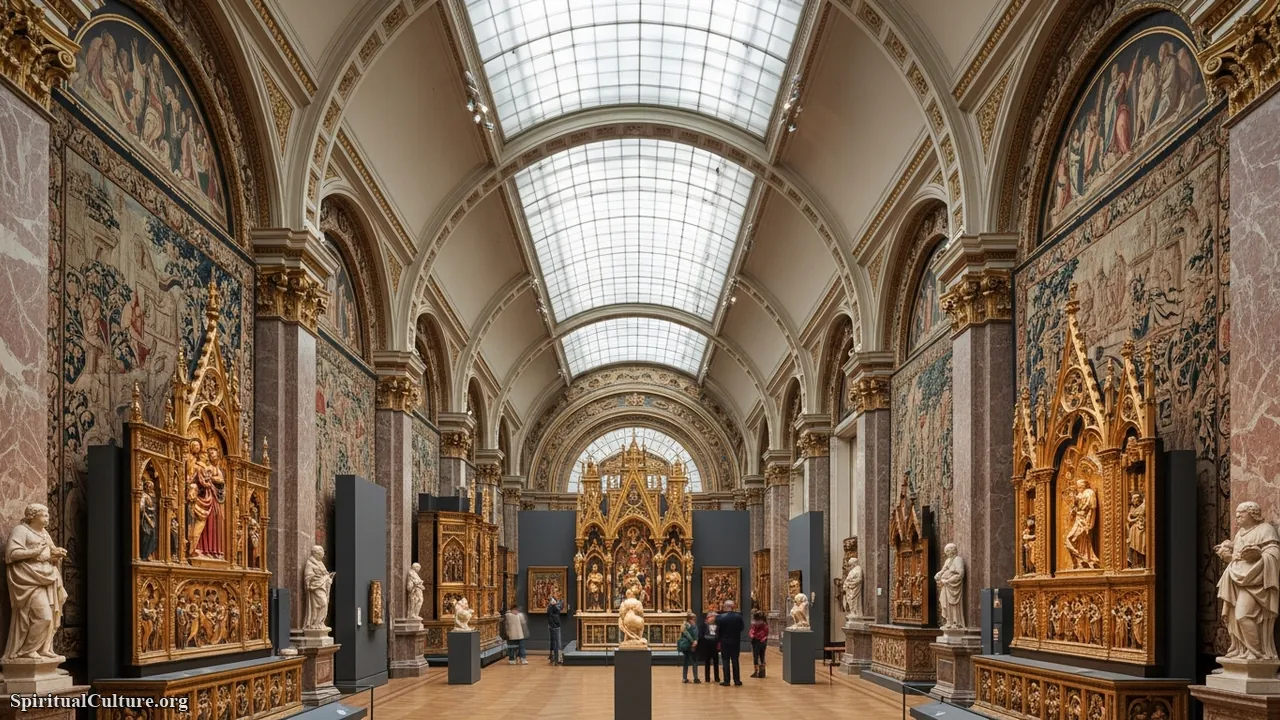
The museum’s Raphael Cartoons are monumental works of religious storytelling, designed for the Vatican’s Sistine Chapel. These tapestries are not just art; they are theological texts woven into fabric. The V&A’s galleries demonstrate how every culture, from the Islamic Middle East to Renaissance Europe, used beauty to honor the divine. The preservation of these delicate textiles and ceramics is an act of respecting the spiritual labor of the artisans.
Walking through the V&A is a lesson in the universality of the sacred. It shows that whether through a tea cup or a cathedral door, humans have always sought to imbue matter with spirit, transforming raw materials into objects of reverence and meaning.
Cultural & Spiritual Highlights:
- The Raphael Cartoons: Monumental religious designs depicting the lives of St. Peter and St. Paul.
- Sacred Silver & Gold: Extensive collections of chalices and reliquaries used in divine worship.
- Ardabil Carpet: A masterpiece of Islamic art reflecting the spiritual geometry of the divine order.
Top 4. The National Gallery (London)
Overlooking Trafalgar Square, the National Gallery acts as a sanctuary of contemplation in the heart of a chaotic city. It is home to one of the greatest collections of Western European painting, which is inextricably linked to the history of Christianity. For centuries, art was the “Bible of the illiterate,” and this museum preserves the visual theology of the West.

The spiritual impact here is direct and visual. Works by da Vinci, Botticelli, and Raphael depict the most sacred moments of the Christian narrative—the Annunciation, the Crucifixion, and the Resurrection—with an emotional intensity that transcends time. The gallery has embraced this heritage with exhibitions like “Fruits of the Spirit,” which invited visitors to pair paintings with virtues like love, joy, and peace.
To visit the National Gallery is to engage in a form of visual meditation (“Visio Divina”). The museum allows secular audiences to confront the intense devotion of the past, offering a space where the beauty of the artwork invites a quiet, reverent introspection that is rare in modern life.
Cultural & Spiritual Highlights:
- Wilton Diptych: A rare portable Gothic altarpiece symbolizing the divine right and personal devotion of kings.
- “Fruits of the Spirit”: A thematic approach linking art history directly to biblical virtues.
- Leonardo’s Virgin of the Rocks: A masterpiece inviting contemplation on the mystery of the Incarnation.
Top 3. Tate Modern (London)
Housed in a former power station, the Tate Modern is a cathedral of the industrial age transformed into a temple of the avant-garde. It ranks high on our list because it represents “Modern Spirituality”—the search for meaning in a secular, fragmented world. The massive Turbine Hall often hosts installations that provoke awe, silence, and communal experience on a scale similar to religious rituals.

Abstract Expressionism and Surrealism, heavily featured here, are deeply spiritual movements. Artists like Rothko (whose Seagram Murals are a somber, meditative focal point) sought to express the “tragedy and ecstasy” of the human condition without using traditional religious figures. The museum documents how, when traditional religion faded for many in the 20th century, art became the new vessel for exploring the subconscious and the divine.
The Tate Modern challenges us to find the spirit in the void, the light in the darkness, and the meaning in the abstract. It is a place of pilgrimage for the modern soul seeking connection, provocation, and a sense of the sublime outside of traditional dogma.
Cultural & Spiritual Highlights:
- Rothko Room: A dedicated sanctuary for meditative, almost religious, absorption in color and void.
- Turbine Hall Commissions: Large-scale installations that create communal, awe-inspiring experiences.
- Surrealism & Occult: Collections exploring the dream world, magic, and the non-rational human spirit.
Top 2. Natural History Museum (London)
Entering the Natural History Museum is like entering a cathedral; indeed, the architecture is intentionally ecclesiastical, featuring terra cotta tiles depicting flora and fauna rather than saints. It is the “Cathedral of Nature,” a place that tells the grandest story of all: the history of creation and life on Earth. Its spiritual value lies in its power to humble us.
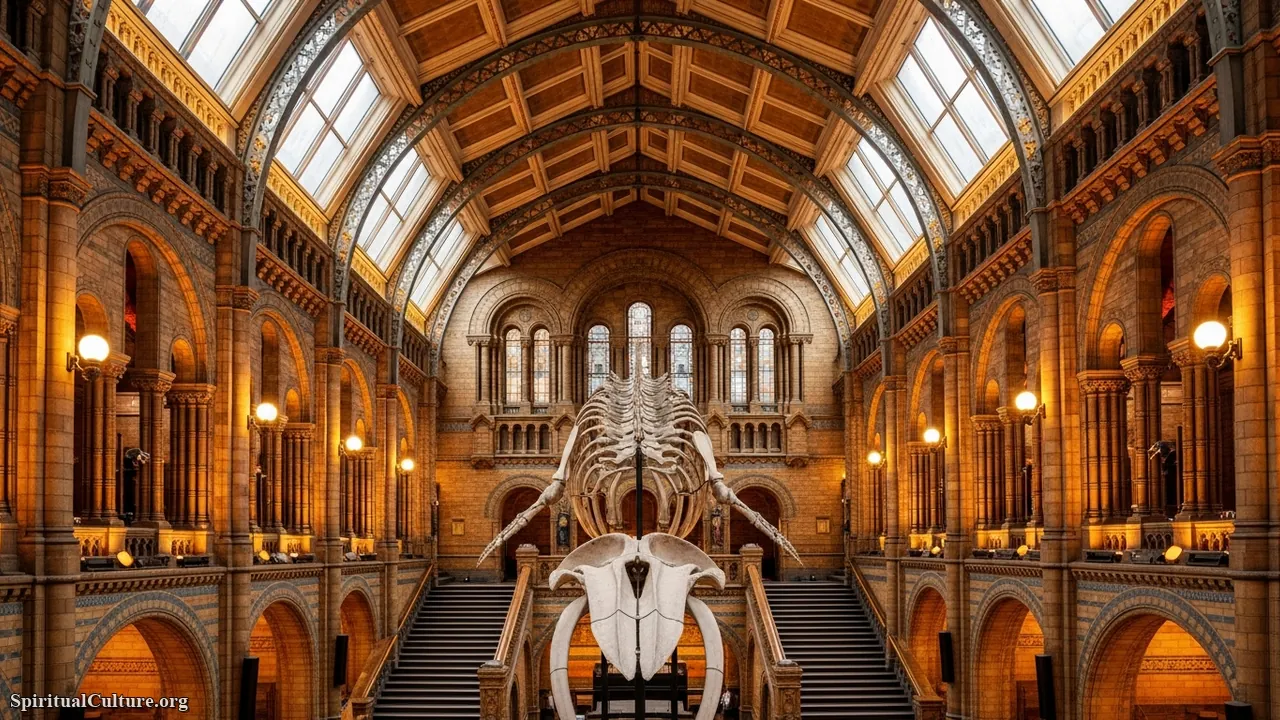
Standing beneath the skeleton of the blue whale “Hope” in the main hall, visitors are compelled to feel a sense of stewardship and connection to the natural world. The museum bridges the gap between the scientific theory of evolution and the spiritual responsibility we have to protect God’s creation (or the biosphere). It answers the question of our place in the lineage of life.
The museum serves as a repository of the “Book of Nature.” It fosters a spirituality of ecological awareness, reminding us that we are fleeting passengers on an ancient planet. The awe inspired by the dinosaurs or the gemstones is the same awe that drove the psalmists to write about the wonders of the earth.
Cultural & Spiritual Highlights:
- Hintze Hall (The Cathedral Nave): Designed as a “Temple of Science” with ecclesiastical architecture.
- Hope the Whale: A symbol of environmental stewardship and the fragility of creation.
- Human Evolution Gallery: Provokes deep philosophical questions about what it means to be human.
Top 1. The British Museum (London)
Topping our list is the British Museum, the ultimate archive of the human soul. Established in 1753, it was the first national public museum in the world. Its scope is not just national but planetary, housing the cultural and spiritual heritage of every continent. It is the only place on Earth where one can walk from an Easter Island Moai to the Rosetta Stone, and then to the Parthenon Sculptures, in a single afternoon.

The spiritual impact of the British Museum is unmatched because it documents the entire history of human belief. From Egyptian Books of the Dead that map the afterlife to Aztec serpent mosaics used in rituals, the collection is a testament to humanity’s eternal search for the divine. It allows for a comparative study of religion that highlights our shared fears, hopes, and rituals across millennia.
While the debates regarding repatriation of artifacts are significant and acknowledge the pain of cultural loss, the museum currently serves as a unique “World Library of Things.” It teaches the profound lesson that despite our vast differences in geography and time, the human spirit has always expressed itself through the creation of sacred objects. It is a monument to our collective heritage.
Cultural & Spiritual Highlights:
- The Rosetta Stone: The key to unlocking ancient wisdom and lost languages.
- Egyptian Sculpture Gallery: A massive display of colossal statues dedicated to gods and pharaohs.
- Living and Dying Gallery: Explores how different cultures spiritually navigate health, suffering, and the afterlife.
- Sutton Hoo Ship Burial: The ultimate symbol of Anglo-Saxon beliefs in the voyage of the soul.
Conclusion
At Spiritual Culture, we see these ten museums not merely as tourist attractions, but as vital organs in the body of our collective culture. They are sanctuaries where the noise of the modern world fades, replaced by the silent yet powerful voices of the past. Whether it is the hushed reverence of the Rothko Room at the Tate or the ancestral gaze of the Lewis Chessmen in Edinburgh, these places force us to slow down and confront the “Long Now” of history.
In 2025, as the world becomes increasingly digital and ephemeral, the physical presence of these artifacts becomes even more spiritually grounding. They remind us that we are part of a continuum. To visit them is to pay respects to the millions of hands that carved, painted, and preserved our reality. We encourage you to visit not just to see, but to feel the weight of the heritage they hold.



